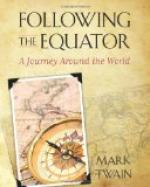The Peninsula is lofty, rocky, and densely clothed with scrub, or brush, or both. It is joined to the main by a low neck. At this junction was formerly a convict station called Port Arthur—a place hard to escape from. Behind it was the wilderness of scrub, in which a fugitive would soon starve; in front was the narrow neck, with a cordon of chained dogs across it, and a line of lanterns, and a fence of living guards, armed. We saw the place as we swept by—that is, we had a glimpse of what we were told was the entrance to Port Arthur. The glimpse was worth something, as a remembrancer, but that was all.
The voyage thence up the Derwent Frith displays a grand succession of fairy visions, in its entire length elsewhere unequaled. In gliding over the deep blue sea studded with lovely islets luxuriant to the water’s edge, one is at a loss which scene to choose for contemplation and to admire most. When the Huon and Bruni have been passed, there seems no possible chance of a rival; but suddenly Mount Wellington, massive and noble like his brother Etna, literally heaves in sight, sternly guarded on either hand by Mounts Nelson and Rumney; presently we arrive at Sullivan’s Cove—Hobart!
It is an attractive town. It sits on low hills that slope to the harbor —a harbor that looks like a river, and is as smooth as one. Its still surface is pictured with dainty reflections of boats and grassy banks and luxuriant foliage. Back of the town rise highlands that are clothed in woodland loveliness, and over the way is that noble mountain, Wellington, a stately bulk, a most majestic pile. How beautiful is the whole region, for form, and grouping, and opulence, and freshness of foliage, and variety of color, and grace and shapeliness of the hills, the capes, the, promontories; and then, the splendor of the sunlight, the dim rich distances, the charm of the water-glimpses! And it was in this paradise that the yellow-liveried convicts were landed, and the Corps-bandits quartered, and the wanton slaughter of the kangaroo-chasing black innocents consummated on that autumn day in May, in the brutish old time. It was all out of keeping with the place, a sort of bringing of heaven and hell together.
The remembrance of this paradise reminds me that it was at Hobart that we struck the head of the procession of Junior Englands. We were to encounter other sections of it in New Zealand, presently, and others later in Natal. Wherever the exiled Englishman can find in his new home resemblances to his old one, he is touched to the marrow of his being; the love that is in his heart inspires his imagination, and these allied forces transfigure those resemblances into authentic duplicates of the revered originals. It is beautiful, the feeling which works this enchantment, and it compels one’s homage; compels it, and also compels one’s assent—compels it always—even when, as happens sometimes, one does not see the resemblances as clearly as does the exile who is pointing them out.




